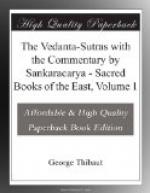Adhik. X (14).—Good deeds likewise lose their efficiency.—The literal translation of the Sutra is, ’There is likewise non-attachment (to the vidvan) of the other (i.e. of the deeds other than the evil ones, i.e. of good deeds), but on the fall (of the body, i.e. when death takes place).’ The last words of the Sutra, ‘but on the fall,’ are separated by Sa@nkara from the preceding part of the Sutra and interpreted to mean, ’when death takes place (there results mukti of the vidvan, who through his knowledge has freed himself from the bonds of works).’—According to Ramanuja the whole Sutra simply means, ’There is likewise non-attachment of good deeds (not at once when knowledge is reached), but on the death of the vidvan[19].’
Adhik. XI (15).—The non-operation of works stated in the two preceding adhikara/n/as holds good only in the case of anarabdhakarya works, i.e. those works which have not yet begun to produce their effects, while it does not extend to the arabdhakarya works on which the present existence of the devotee depends.
Adhik. XII (16, 17).—From the rule enunciated in Adhik. X are excepted such sacrificial performances as are enjoined permanently (nitya): so, for instance, the agnihotra, for they promote the origination of knowledge.
Adhik. XIII (18).—The origination of knowledge is promoted also by such sacrificial works as are not accompanied with the knowledge of the upasanas referring to the different members of those works.
Adhik. XIV (19).—The arabdhakarya works have to be worked out fully by the fruition of their effects; whereupon the vidvan becomes united with Brahman.—The ‘bhoga’ of the Sutra is, according to Sa@nkara, restricted to the present existence of the devotee, since the complete knowledge obtained by him destroys the nescience which otherwise would lead to future embodiments. According to Ramanuja a number of embodied existences may have to be gone through before the effects of the arabdhakarya works are exhausted.
PADA II.
This and the two remaining padas of the fourth adhyaya describe the fate of the vidvan after death. According to Sa@nkara we have to distinguish the vidvan who possesses the highest knowledge, viz. that he is one with the highest Brahman, and the vidvan who knows only the lower Brahman, and have to refer certain Sutras to the former and others to the latter. According to Ramanuja the vidvan is one only.
Adhik. I, II, III (1-6).—On the death of the vidvan (i.e. of him who possesses the lower knowledge, according to Sa@nkara) his senses are merged in the manas, the manas in the chief vital air (pra/n/a), the vital air in the individual soul (jiva), the soul in the subtle elements.—According to Ramanuja the combination (sampatti) of the senses with the manas, &c. is a mere conjunction (sa/m/yoga), not a merging (laya).




